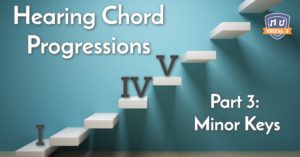As do any other lovers, we musicians consume all our heart, mind, body, and soul with the music we love. But sometimes, like in any other love relationship, that’s not enough to move us forward. We wonder, “With all that time, love, and attention – why aren’t we growing musically?”
Often, with all our focus on our beloved, we neglect the other areas in our lives that sustain that relationship and made it possible in the first place.
In the musical realm, that means practicing, ear training, career, and – gasp – music theory.
So this week in Musical U we tamed the dreaded theory beast, known as the Circle of Fifths. We also learned how to home in on those under-the-radar gigs and how to really hear those minor chord progressions.
But first, let’s see how to make your practicing deliver the musical goods you crave:
Business Lessons from the Practice Room
 Busy busy busy. When do you practice, and how? Looking back, it was a lot easier when mom and dad were squeezing those 30 minutes out of your whiny feelings of injustice. But now the luxury of watching the second hand tick down the last 30 seconds of your practice time is gone, gone, gone and never to return.
Busy busy busy. When do you practice, and how? Looking back, it was a lot easier when mom and dad were squeezing those 30 minutes out of your whiny feelings of injustice. But now the luxury of watching the second hand tick down the last 30 seconds of your practice time is gone, gone, gone and never to return.
And now that you really want to practice, when are you going to do it? And how do you get the most out of that practice time?
Musical U founder Christopher Sutton answered these questions and more in a fascinating conversation with Steve Palfreyman of Music Launch Hub – Mastermind Tribe. In the process, they discovered that extracting the most musical bang for your buck from your practicing isn’t all that different from what it takes to the career moves that support your musical habit…. uh, relationship.
Read more about what happens when Musical U Meets Music Launch Hub, Part 1: Practicing Music, Practicing Business.
Minor Ear Training for Major Results
 Ear training is another one of those practices that may seem like an “extra” – but that will fundamentally transform your musicianship. In a short series on Hearing Chord Progressions, Musical U author Ramona Cojocaru mixed up a powerful brew of solfa (aka solfege) and music theory to supercharge your hearing of major chord progressions. Now she addresses the rich minor sonorities in Hearing Chord Progressions, Part 3: Minor Keys.
Ear training is another one of those practices that may seem like an “extra” – but that will fundamentally transform your musicianship. In a short series on Hearing Chord Progressions, Musical U author Ramona Cojocaru mixed up a powerful brew of solfa (aka solfege) and music theory to supercharge your hearing of major chord progressions. Now she addresses the rich minor sonorities in Hearing Chord Progressions, Part 3: Minor Keys.
Music Theory can seem complex, with so many rules that the musician must remember to properly build chords, scales, and harmony. What if we could break it down into something much easier? Kennis Russell put together this quick video to show how Major and Minor chords can be simplified:
Minor keys can greatly impact the tonal variety of your music, introducing new colors and texture. When using a minor key, the chords that correspond to the melody will change as well. But, what chords can you use? Piano Keyboard Guide provides this breakdown of C# minor that will have you playing in no time.
Learning the theory behind minor chord progressions is one thing. Being able to apply it directly to your instrument is another! Guitar and Music Institute has a quick lesson on using minor chords progressions all over the fretboard to take your playing to the next level.
The lesson ended by briefly discussing how tonality is further expanded through the use of harmonic and melodic minor scales. These exotic scales can add a great deal of interest to your melodies and open your ear to more tonal possibilities! JamPlay has published this guide to Harmonic Minor Modes that will get you started on your minor journey.
Circle of Fifths, Unveiled
 What if you could fit everything you ever could possibly want to know about scales, harmony, chords, and chord progressions into a small diagram that fit in the palm of your hand?
What if you could fit everything you ever could possibly want to know about scales, harmony, chords, and chord progressions into a small diagram that fit in the palm of your hand?
The Circle of Fifths is that magical musical master tool. While the mind-boggling possibilities of the Circle are infinite, there’s no longer any need for your own mind to be boggled or intimidated or to hide under a small rock quaking in fear – for this week, Musical U unveils The Ultimate Guide to the Circle of Fifths.
With this guide, you can go for the whole thing at once, or you can easily break off bite-sized chunks, coming back again and again to the Ultimate Guide and the free downloadable Circle of Fifths PDFs. Once you’ve grasped this precious musical Ring of Power, you will never let go.
The secrets behind the Circle of Fifths are vast. Diving into this subject will greatly improve your capabilities as a musician. Perhaps you still have some questions, though. Music is Win answers questions from their message board to point you in the right direction:
Patterns are everywhere in music. The Circle of Fifths is a prime example of how music theory and understanding these patterns can greatly increase the musician’s ability to hear and play the music. Join Theta Music Trainer in exploring the patterns behind the Circle of Fifths.
So, now that you know about the Circle of Fifths, what are you to do with it? One way to start is through chord progressions. With Jazz Tutorial, see how to build the chords within any scale using the circle of fifths:
You may be thinking that boring subjects like music theory and the Circle of Fifths don’t matter to you. But, every musician benefits from understanding and using this amazing tool. Sound Girls provides us with insight on how songwriters and music producers can use the Circle of Fifths.
Under the Radar Gigs
 Ever dream of leaving behind the “day job” and devoting your whole life to what you love the most (aka music!)? There’s a whole world of gigs, lucrative gigs – perhaps even an entire music career – lurking in places you never thought to look. Dave Ruch stumbled upon this discovery for himself, and is now helping others do the same – hopefully minus the stumbling part.
Ever dream of leaving behind the “day job” and devoting your whole life to what you love the most (aka music!)? There’s a whole world of gigs, lucrative gigs – perhaps even an entire music career – lurking in places you never thought to look. Dave Ruch stumbled upon this discovery for himself, and is now helping others do the same – hopefully minus the stumbling part.
Find out how to Discover Your Unexpected Music Career, with Dave Ruch.
Such a fascinating journey! Dave found his passion by accepting a gig from an unexpected source, playing for an unanticipated audience. By expanding your search for gigs, you may find something similar. The Female Musician Academy has some tips on where you can find paying gigs in less traditional venues that may open these doors.
Gigs can come from many unexpected places! As you build your network and repertoire, continuing to expand your search can help to yield better-paying gigs, in more preferred venues. MondoTunes starts you off with five ways to get more gigs.
Being a performing educator has required Dave to approach live performances differently than a “normal” musician. By embracing some of the best practices of music education, he has been able to reach audiences in new, exciting ways. The Musician’s Way has a fascinating article on attributes of effective teachers that will help you find your inner music educator.
Looking for a new audience for your songwriting talent? Grown ups that look like you aren’t the only people who listen to songs. Meet Kate Whitley, a composer that writes music for young audiences, and find out how to expand your own audience – and creativity.
Inspired to try your hand at educational songwriting? To help get you started, composer Jonathan Dove offers his top tips for writing music for children.
Look Around You
Sometimes we’re so focused on the music we love that we forget to give attention to the aspects of life that will bring us even closer with and deeper into our musical understandings and expressions.
Today it’s time to find new gigs in surprising places- they can help us uncover parts of our musical selves we didn’t even know existed. Train your ears to follow minor chord progressions and you open up new areas of enjoyment and expression. Learn how effective practicing brings us closer, and faster, to our musical and career goals. And dive into the depths of the Circle of Fifths – an endless wellspring of musical wisdom and usefulness.
The post Find Gigs, Circle of Fifths, Better Practice, Minor Progressions appeared first on Musical U.